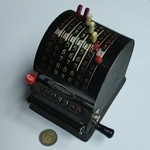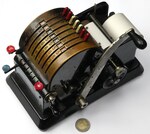

The Lipsia Addi 7
The Lipsia Addi 7 with printer
Video
History
Books
Promotional material
Articles and advertisements
Patents
Links
The Lipsia Addi 7 is a small adding machine. It has a 7-digit register, and 7 input levers. When you set the levers to a particular number, that register is immediately updated. You can then reset the input by pressing down the bar at the front, after which the next number can be entered and added to the register. A turn of the small crank on the right will clear the register.
It can also subtract. To do this hold down the red button marked SUBT while setting the input to the number you want to subtract. This will not yet affect the register. Release the red button and manually set all the input levers back to zero. This subtracts the number from the register.
It is important to note that the levers should be moved individually. If you move several levers simultaneously, a carry operation may get lost so that the wrong answer is computed.
It has a serial number on the base, 34,481. It was in production from about 1930 until probably the early 1950s. This is one of the last ones, because the decal on the back names VEB Metallbau and this started in about 1950.
The mechanism is relatively simple. Each lever is connected to a large wheel that has a section with gear teeth. That section is hinged so that it can either interact with the adjacent register number wheel or not. In normal operation they interact, so moving the levers directly adds to the register. By pressing the minus button the hinged sections no longer interact, allowing you to set the levers without affecting the register. When pressing the input clearing bar, the lever alignment mechanism is released and the subtraction button is also activated. This makes the levers move freely, and they are then pulled back by springs to the zero position.
A version of the Addi 7 was made that had a printing mechanism. It was not very successful, so is quite rare. This variant seems to have only been made in the 1930s.
The adding machine part is virtually identical to the non-printing version. The only difference is that the blue button on the left replaces the bar for clearing the input. The button is rarely used, since the printing action will normally also trigger the clearing of the input.
The printing is performed by pulling the big lever on the right of the machine. The number that is shown in the input at that moment will be printed onto the paper roll at the back. This will also feed the paper through one line width, shift the ink ribbon slightly, and clear the input.
If you perform subtraction, pressing the S button will temporarily disable the automatic clearing of the input, allowing the number to be printed and then subtracted as normal by manually pushing the input pins to zero. When the number is printed, a minus sign will be appended.
It is not possible to print the main register directly. You can press the asterisk button so that the next printing action will print an asterisk after the number to indicate it is a total or subtotal. You can then use the S subtract button to set the input register to the number you want to print, usually the value that is in the main register.
There is a design flaw. The printing lever rests against a rubber stopper, and if the rubber degrades it allows the lever to move too far and hit the metal guide for the ink ribbon. This must have happened on this machine, as the guide has broken off and been replaced by a guide made from bent wire. In later versions of the machine the rubber stopper was moved to just above the ribbon guide to avoid this problem. They also added a rear cover over the paper roll.
This machine has serial number 9,599 which dates it to about 1931 or so.
In 1914 Otto Holzapfel founded the company "Lipsia Rechenmaschinen-Fabrik O. Holzapfel & Cie". Lipsia is the latin name for Leipzig, just like Brunsviga was the Latin name for Braunschweig (Brunswick). Holzapfel had worked for Triumphator, which was based in Leipzig, and he remained there to start his company.
The first World War meant the company only started producing pinwheel calculators in 1919. In 1927 it also started making small adders. The first of these was the Lipsiaddi, a very simple adder (see the Resulta A for a similar machine), but in around 1930 came the Addi 7. They also made the Addi 9, which had 9 digits.
Leipzig is in East Germany so after the second World War the calculators Lipsia was producing were now mostly for use in the Eastern Bloc. In 1950 Lipsia became a subsidiary of VEB Metallbau, and Addi 7 machines like mine bear this company name. In 1953 the East German government took full control of the assets and it was merged into Triumphator. Meanwhile in West Germany from 1949 till 1958 the company Regent-Feinbau was able to make and sell an exact copy of the Addi 7 called the Argenta.
It is unclear whether Triumphator ever actually produced the Addi 7, but in 1957 they released the Triumphator KA to replace it. It was in production for about three years. The Triumphator company was taken over by VEB Buchungsmaschinenwerk Karl-Marx-Stadt in 1969 and Triumphator then ceased to exist as a brand.
Tabellen zur "Lipsia" Rechenmaschine (PDF, 12.2 MB or archive.org)
Lipsia-Rechenmaschinenfabrik O. Holzapfel & Cie.
1927-1930
20 page stapled book
145mm × 215mm
This is a book of useful tables for use with the Lipsia pinwheel calculators. It has no copyright year, but at the back it shows the Lipsiaddi, which was in production from 1927 until it was replaced by the Lipsia Addi 7 in 1930.
Ein Gebot der Klugheit und Vernunft
Lipsia-Rechenmaschinenfabrik O. Holzapfel & Cie.
1930s
One-sided flyer
210mm × 297mm
Here are two almost identical flyers for the Lipsia Addi 7, or 7E. It has usage instructions, but seems to be intended more as an advertisement.
Lipsia Model 11R Flyer
Lipsia-Rechenmaschinenfabrik O. Holzapfel & Cie.
1930s?
One-sided flyer
210 mm × 148mm
Here are a few adverts and articles that mention Lipsia which I found in online newspaper and magazine archives.
| Patent | Filing date | Publish date | Name | Description |
|---|---|---|---|---|
| DE 513,495 | 01-03-1930 | 28-11-1930 | O. Holzapfel & Cie | Lipsia Addi 7 |
© Copyright 2019-2024 Jaap Scherphuis, mechcalc a t jaapsch d o t net.